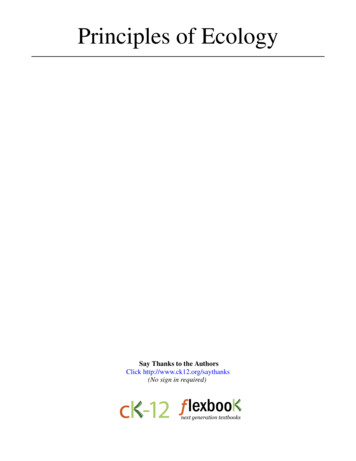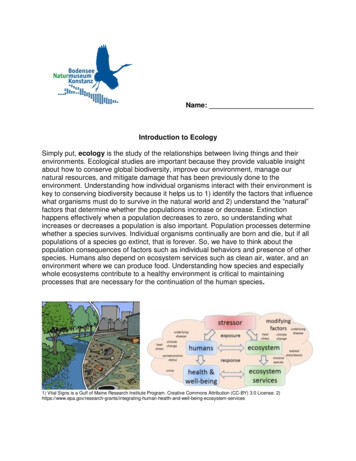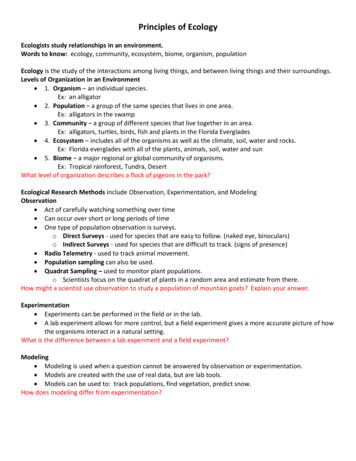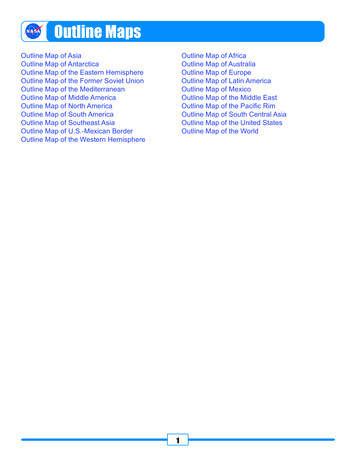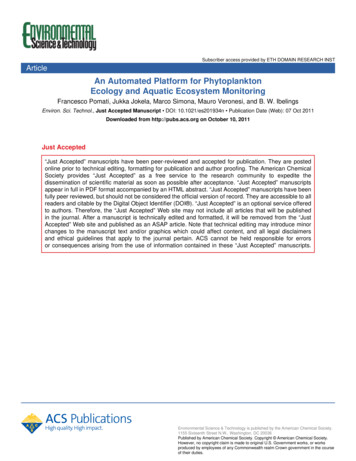
Transcription
Ecology Outline1.Intro to EcologyA. Definition, ExamplesB. Plant Ecology, Photosynthesis2.Basic Ecology ConceptsA. Biodiversity: Maryland, MD ForestsB.Four Levels of Ecology:ii. Species: Cultivars, Keystone, Indicatoriii. Population: Interactions; flower typesiv. Community: Succession; Invasive Exoticsv. Ecosystem: Nutrient CyclesC.Habitat vs. NicheD.Adaptations: Plant Defense
Garden Ecology: It Happens1. Your garden can be an exciting ecosystem - with flowingenergy, interacting communities and recycling nutrients.2. Bugs, chewed leaves and uninvited plants are notnecessarily bad things in the garden.3. Think globally, garden locally. Gardens can have apositive impact on global ecology. think outside the(flower) box.4. A more diverse and native A healthier, more stable andmore interesting one.5. Understanding ecology can improve your gardening.2
Ecology: Defined⑴ The study of the interactionsbetween an organism and itsenvironment Behavioral Ecologist(2) How these interactionsdetermine its distributionand abundance Population Ecologist(3) The flow of energyand the cyclingof matter that occurs.Ecosystem Ecologist3
Solving a puzzle:Acid Rain Example1. Air pollution mixes withrain, lowers pH (acidic) 2. Acid Rain leeches calciumcarbonate out of the soil.3. Less calcium in soil leadsto fewer snails in forest 4. Fewer snails eaten bybirds means less calciumin the birds’ bodies andless successful egg laying.5. Bird populations decline4
PhotosynthesisCO2 H20CH2O OCarbon watersugar oxygen DioxidePart 1 – The Light Reactions Sun energy captured by pigments Splits water into H and O (oxygen released) Produces “ATP” chemical energyPart 2 – The Light Independent Reactions Chemical energy is used to add the H fromwater to CO2 to make sugar.5
Basic Ecology Concepts:BiodiversityBiological Diversity:The sum total of all living things in an area.“Little fleas have lesser fleasUpon their backs to bite them.And lesser fleas, still lesser fleas,and so proceed ad infinitum.”Biodiversity Analogies: Plane Rivets & Jenga GameBenefits are more: productive/efficient, stable, resistant toinvasion, services for us (oxygen, clean water, wildlife)6
Maryland’sBiodiversityDespite its small size, Maryland ishome to an abundance of speciesExample: 300 bird species 3,000 plant species (2/3 native) Good diversity of soils, geology, climate and habitats Western Maryland is home for somemore typically “northern” species Southern Maryland is home for somemore typically “southern” species7
Maryland Forests8
Maryland ForestsBy Percentages Historically: 95% of total land Today: 39% forested (2.6 million acres) 76% of forested land privately owned84% of the ‘privately owned forest’ is 10 acresMany private landowners are 65 years oldLoss of farmland 50% since 1950 (-2.1 million acres)Some Implications Forests are relatively stable due to concentrateddevelopment and old fields/farms ‘reverting’ farmland Many of Maryland’s small forest lots will be changing9hands soon; and State’s control is limited (Fragmentation)
Levels of Organization4. Ecosystem3. Community2. Population1. Species10
Native Plant ‘Cultivars’Cultivar: Cultivated variety of a plant -- selected,propagated and named for a particular characteristic.Attempt to make better plants. More attractive ‘natives:’more petals, different height, new color flowers, etc.Better for whom?Impact on ecology / other organisms is not known.Example: anthracnose-resistant dogwoodHard to find native plants to purchase.Even harder to find “pure” native species.11
Indicator SpeciesIndicator – a somewhat specialized species whosepresence indicates a specific ecosystemKeystone SpeciesA species whose influence on acommunity is disproportionatelylarger than its presence Sea Otter:Affect sea urchinskelp forestfishBeaver:Pond alters the entire ecosystemWolf (in Yellowstone):Affects elk & deer behavior aspens12
Level 2: PopulationA group of organisms of the same speciesInteracting Populations:Right now you have more organisms living on you (or in you)than the entire human population on earth. Some help you,some harm you, some have no m o 13
Parasitism ( /-)Good parasites don’t kill their hosts Chestnut blight – bad parasite Mistletoe Ticks CowbirdCommensalism ( /o): Algae on box turtle’s shell Cattle egrets on cattle’s back Epiphtye on a tree trunk Cinnamon Fern & HummingbirdsMutualism ( / ) Flowers & insects pollinators Lichens fungus and algae Birds and berries seed dispersal Ants and Eliasomes14
Flower Advantages1. Attract animal pollinators (not just wind)2. More efficient, especially if you targetspecies3. Fruits enhanced seed dispersalRead a flower Wind flowers Bumblebee Flowers Fly/Beetle Flowers Butterfly Flowers Moth flowers15
Bumblebees Long Season Generate Heat Big & Strong Long Tongue “Buzz” PollinateWildflowersthat benefitfrom BumblebeePollinationGreenhouse flowersthat benefit from BuzzPollination (Sonication):TomatoesShooting StarKiwiSolomon’s rtleheadCucumbersPeppersEggplant16
Butterfly FlowersColorful, tube-shaped (long tongues), place to land,more nectar than pollen. Butterfly Weed, Black EyedSusan, Coneflower, Phlox, Joe Pye Weed, Bergamot.Moth FlowersNocturnal blooms, smell more at night, white, long tube.More nectar than pollen. Honeysuckle, Primrose,Jimsonweed.Fly / Beetle FlowersBrownish in color, bad smell, low to ground, more pollenthan nectar. Purple Trillium, Wild Ginger, SkunkCabbage, Carrion Flower.17
High-Energy BerriesDogwoodBlackgumSpicebushMagnoliaSassfras18
Elaiosome Found in many native early spring ephemeral wildflowers These plants often have smaller seeds, less-appealing to animals Nutrient rich seed attachmentBut:Dutchman’s BreechesTrilliumTrout lilyBloodrootHepaticaVioletsWild Bleeding Heart Release their seeds with a ‘reward’when there is less competitionResult: Ant seed-dispersal Myrmecochory19Wood poppy
Level 3: CommunityCommunity: A group of interacting plant and animal populationsSuccession: The replacement of one type of community withanother over time.Maryland’s “climax” community is eastern temperate deciduousforest.20
Top 15 Native Woody PlantsNameGenusButterfly/Moth SpeciesOakQuercus534Black cherry ilia21
Level 4: EcosystemA community and its surrounding environment treated as afunctional system linked by energy flows and nutrient cyclesWhich Nutrients?The “Schnapps” Cycles: r22
Carbon CycleWhy care?Carbon: Essential element - all life is based on it.50% of our dry weight carbon.4th most abundant element in universe after(Hydrogen, Helium & Oxygen)Organic carbonCO2 is a “greenhouse gas” (climate change)30% more CO2 in atmosphere than 150 years ago23
Climate ChangeProblem:Rise in earth’s overall temperatureCauses and solutions are still debated.Linked with recent rise in “greenhouse gases ” Mostly carbon dioxide (C02), but alsomethane (CH4), nitrous oxide (N2O) and others.Consequences:1. Rising Oceans2. Shifting Populations3. More Severe Storms24
Shifting PopulationsImpact on Bird MigrationBird populations might shift farther north (NA warblers 65 miles)Bird and food coordination could be out of sync(arriving earlier, leaving later)25
Adaptation:A physical or behavioral“inherited” characteristic that improves an organism’sability to survive in its environment.26
How Plants Fight Back:Defense Adaptations1. Physical Defense Thorns & needles Glass-like Crystals in maple leaves2. Chemical Warfare 1: Attack Allelopathy – black walnut, NY fern Phototoxins - St. Johnswort3. Chemical Warfare 2: Communicate Sending Out an SOS - Plants signal wasps Trees release gas that stimulates leaf tannins Ants & Bracken Ferns - extra-floral nectary4. Overwhelm your predators: Mast Years27
D. Adaptations: Plant Defense Ecology Outline. 2 Garden Ecology: It Happens 1. Your garden can be an exciting ecosystem - with flowing . Behavioral Ecologist Population Ecologist Ecosystem Ecologist. 4 Acid Rain Example 1. Air pollution mixes with . Beaver: Pond alters the entire ecosystem Wolf (in Yellowstone):


